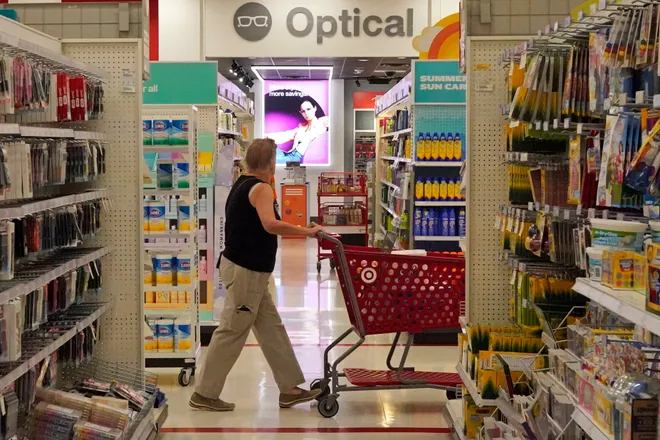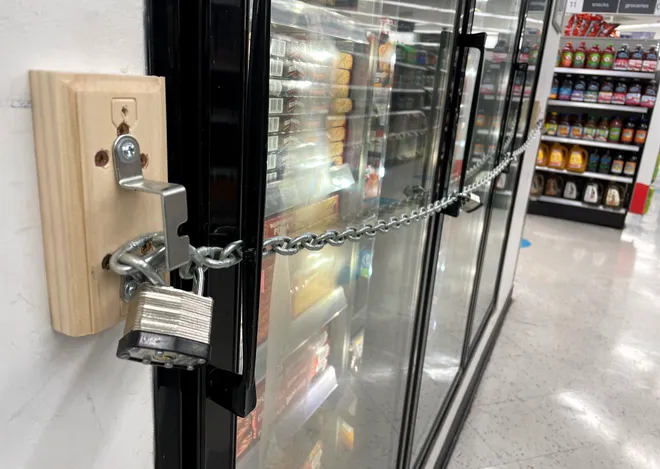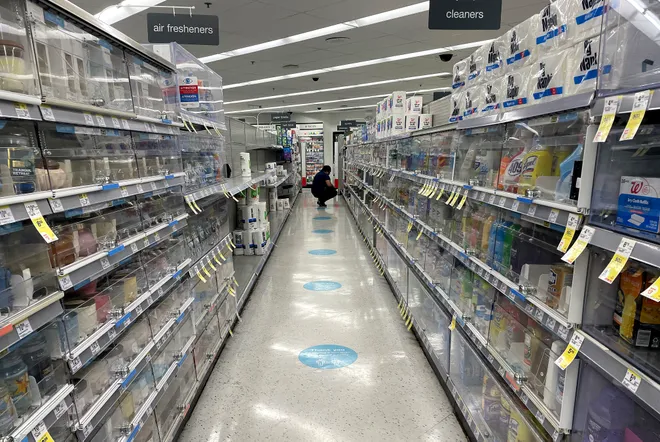Stores are locking up products to curb shoplifters. How that's affecting paying customers.
Running errands isn’t as easy as it used to be. Businesses have been reducing operating hours, locking up items and threatening to shutter stores completely.
The reason for many of these shifts, according to retailers? A spike in theft.
Companies like Target, Walmart, Dollar General and Home Depot have been sounding the alarm on retail theft in recent months. Missing inventory was talked about more during this previous quarter’s earnings call than any quarter on record, according to data compiled by Bloomberg.
While there’s a lack of federal crime statistics available that show how serious retail theft is across the country and some questioning whether companies' concerns are overblown, retailers’ reactions are impacting customers.
“Stores take (theft) on the chin from a profit and loss point of view, but then they pass on this cost of doing business in the form of higher prices,” said Mark Cohen, director of retail studies at Columbia Business School. “Make no bones about it, it's a price that we all pay.”

What is shrinkage?
Retailers have been increasingly concerned about a loss of profits because of shrinkage – an industry term that refers to the difference between the inventory a store has on its balance sheet and its actual inventory.
Home Depot’s Chief Financial Officer in May said the company’s gross margin fell 33.7% in the first quarter primarily from inventory shrink, while Ulta Beauty’s CEO Dave Kimbell said the company updated its full-year guidance to reflect pressure from inventory shrink.
Target CEO Brian Cornell said the company expects shrink – a “worsening trend” – to reduce the company’s 2023 profitability by more than $500 million compared with last year if trends continue.
Cornell said shrink can be driven by multiple factors – the term includes everything from items lost or damaged items to theft by employees or visitors – but he and other executives have raised concerns over a rise in organized retail theft, in which thieves steal merchandise to resell for a profit, often online through sites like Amazon or eBay.

David Johnston, vice president of asset protection and retail operations at the National Retail Federation, a retail trade association, said it’s a growing problem for many retailers. A 2020 report from NRF found organized retail crime cost retailers an average $719,548 per $1 billion in sales in 2020, up from $703,320 in 2019 ‒ less than 1% of sales but "significantly" up from nearly $454,000 in 2015. A more recent report from the trade group said 63 surveyed retailers reported a 26.5% increase in organized retail crime incidents in 2021.
“What we're seeing over the last year that is different from years past is that this shoplifting that is occurring is for a larger purpose. It's to support a growing organized retail crime effort throughout the country,” Johnston said.
How shrink affects shoppers
Safeway cited theft when it cut back the hours of a San Francisco store in 2021, and Walmart CEO Doug McMillon in December warned that a spike in shoplifting could lead to store closures.
Other retailers are turning to more advanced technology, like self-servicing locking cabinets or smart shopping carts. Walgreens in June announced that it is testing a new store concept in Chicago that has most merchandise under lock and key.
Joe Budano, CEO of anti-theft technology company Indyme, said his company is selling 30% more help buttons that can alert an employee that a customer wants an item unlocked compared to 2019.
“They’re locking stuff up like crazy today,” Budano said. “Retailers are just throwing the kitchen sink at (the shrink issue) right now.”
But retailers are also concerned that these sorts of measures can hurt sales by making the shopping experience more difficult. A 2021 report from the Loss Prevention Research Council sponsored by Indyme found nearly 43% of 99 surveyed mystery shoppers would not have gone through with purchasing locked merchandise if not for the assignment.
“Retailers don't want to put merchandise under lock and key,” NRF’s Johnston said. “They understand and recognize that depending on what they do, that could impact the customer's shopping experience. … It’s a delicate balance.”
And locking up items or protecting them with new technology could bode poorly for consumers’ wallets as retailers pass along the higher costs of the added security measures. Dollar Tree CEO Rick Dreiling in May noted that "we all work to mitigate" shrink, but costs "get passed on to the consumer eventually."
What does the data say?
Some of the data pointing to a rise in theft has been contested, with critics questioning if retailers are mistakenly blaming too great a share of their losses on organized crime.
A 2022 report from the NRF found $94.5 billion in losses in 2021 because of shrink, up from $90.8 billion in 2020.
But the average shrink rate actually dropped from 1.6% to 1.4%, according to their findings, meaning the dollar figure spike could be attributed to higher prices because of inflation rather than a spike in shrink or theft.
Johnston told USA TODAY that while NRF believes 37% of 2021’s shrink loss was related to external theft, those estimates are “not scientific.”
“It's not a guess, but it's a best estimate of where their inventory losses are occurring,” he said. “It is based on the capabilities of the individual retailer in their reporting.”
Cohen of Columbia Business School said that while anecdotal evidence suggests theft is on the rise and he has no reason to doubt the issue is as serious as companies suggest, he described accounting for theft as “somewhat of an ambiguous determination.”
“We're in a period of inflation, and there's tremendous pressure on P&L (profit and loss) coming out of two and a half years of chaos and COVID, and a lot of companies are using theft as a reason why their performance is less than what they had hoped it would be,” he said. “Whether they're using it as an excuse, or as a valid reason, it's difficult to know.”
At least one retailer has already walked back its concerns over theft. After blaming a rise of theft for a number of store closures, Walgreens CFO James Kehoe in January said the company may have “cried too much last year” over shrink and has since stabilized its shrink figures.

During the company’s latest earnings call in June, executives said they planned to close an additional 150 U.S. stores “to further simplify the business.” Executives made no mention of shrink or theft during the call.
Federal crime data does little to clear up the murky picture.
Nearly 40% of U.S. law enforcement agencies failed to submit data to the FBI crime statistics collection program in 2021 after it went through a revision, according to The Marshall Project, a nonprofit journalism organization.
The gap in data makes it difficult to analyze crime trends, according to Charis Kubrin, a criminology professor at the University of California, Irvine. She believes that while there are likely certain neighborhoods and cities where theft has risen, others may have seen levels fall.
“The key is identifying at a more local level where this is happening,” she said. “I think claiming that retail theft is out of control, or you know, headlines that are particularly alarmist, I think are really off base because we simply don't know at this point.”
But others argue that law enforcement data isn’t reliable as theft tends to be underreported.
“The police only know what the retailer tells them, and the retailer only reports a certain amount because they don’t know or they haven’t detained anybody,” said Read Hayes, a criminologist at the University of Florida and director of the Loss Prevention Research Council, a retail industry-supported group that helped conduct NRF’s 2022 national retail security survey.
“So the police don't know very much, right? They are doing their best, but they can only they only know what they know,” he added.
What happens next?
Some retailers have been pushing for stricter penalties for stealing to curb retail theft.
Between 2000 and 2018, at least 39 states raised the value of goods thieves need to steal for their crime to be elevated from misdemeanor (which usually results in probation or less than a year in a local jail) to felony (which typically means at least a year in state prison) to clear up prison space. California’s Proposition 47 passed by voters in 2014, for instance, downgraded most small thefts to misdemeanors and raised the threshold for petty theft from $500 to $950.
“What we are seeing, and our retail members most certainly notice this, is that there's also a large increase in violence when people are trying to shoplift and steal, and they're trying to get away without being apprehended,” Johnston said, adding that retailers are trying to get lawmakers at state and local levels to reexamine felony thresholds.
But some data indicates that raising a felony threshold does not have a significant impact on theft.
A 2018 paper from Kubrin found Prop 47 had no effect on robbery or burglary. Larceny and motor vehicle thefts seem to have increased “moderately,” according to the findings, but the results were small enough that it could be due to chance.
Additional research from The Pew Charitable Trusts found raising the felony theft threshold had no impact on overall property crime or larceny rates, and states that increased their felony threshold reported roughly the same average decrease in crime as the 20 states that did not change their theft laws.
Even with concerns over theft running high, a number of retail expert say heightened levels of shrink will likely be a short-lived trend.
“I do think, if we are realistic, this consumable shift and this shrink impact are transitory,” Dollar Tree CEO Dreiling said in May, adding that shrink tends to be cyclical. “I do not believe we're going to be living with them forever, and that is all accretive to what we're doing.”
Lawmakers have already taken action against organized retail theft. The bipartisan Inform Consumers Act, which went into effect in June, aims to curb organized retail theft by requiring online marketplaces like Amazon and eBay to verify sellers' information.
“Maybe in a year or two, (retailers will) calm down a bit and they'll maybe be able to pull back on some of this,” Budano of Indyme said.
Disclaimer: The copyright of this article belongs to the original author. Reposting this article is solely for the purpose of information dissemination and does not constitute any investment advice. If there is any infringement, please contact us immediately. We will make corrections or deletions as necessary. Thank you.







